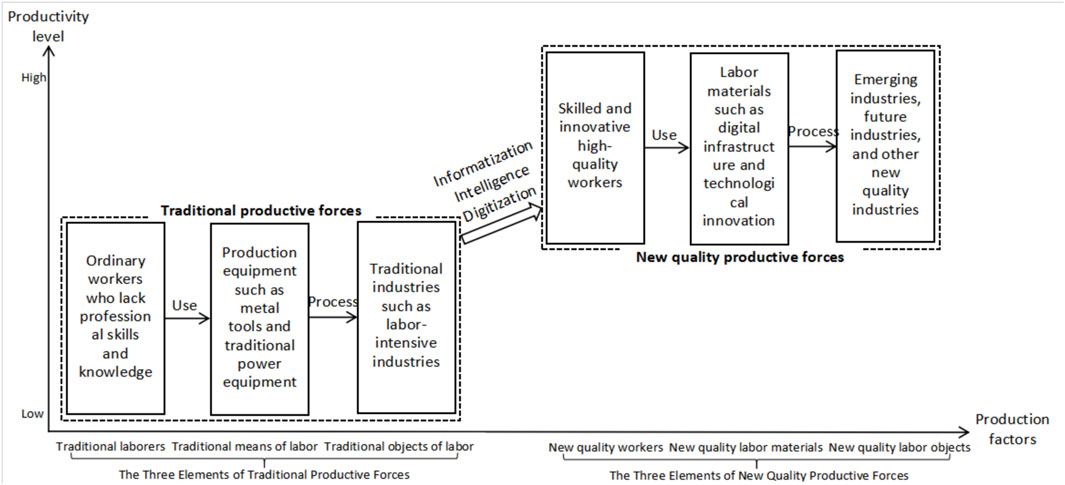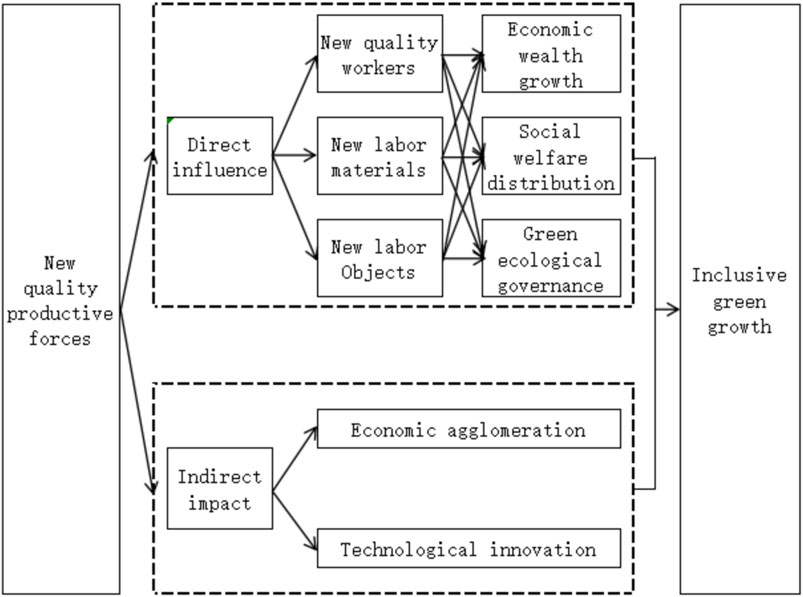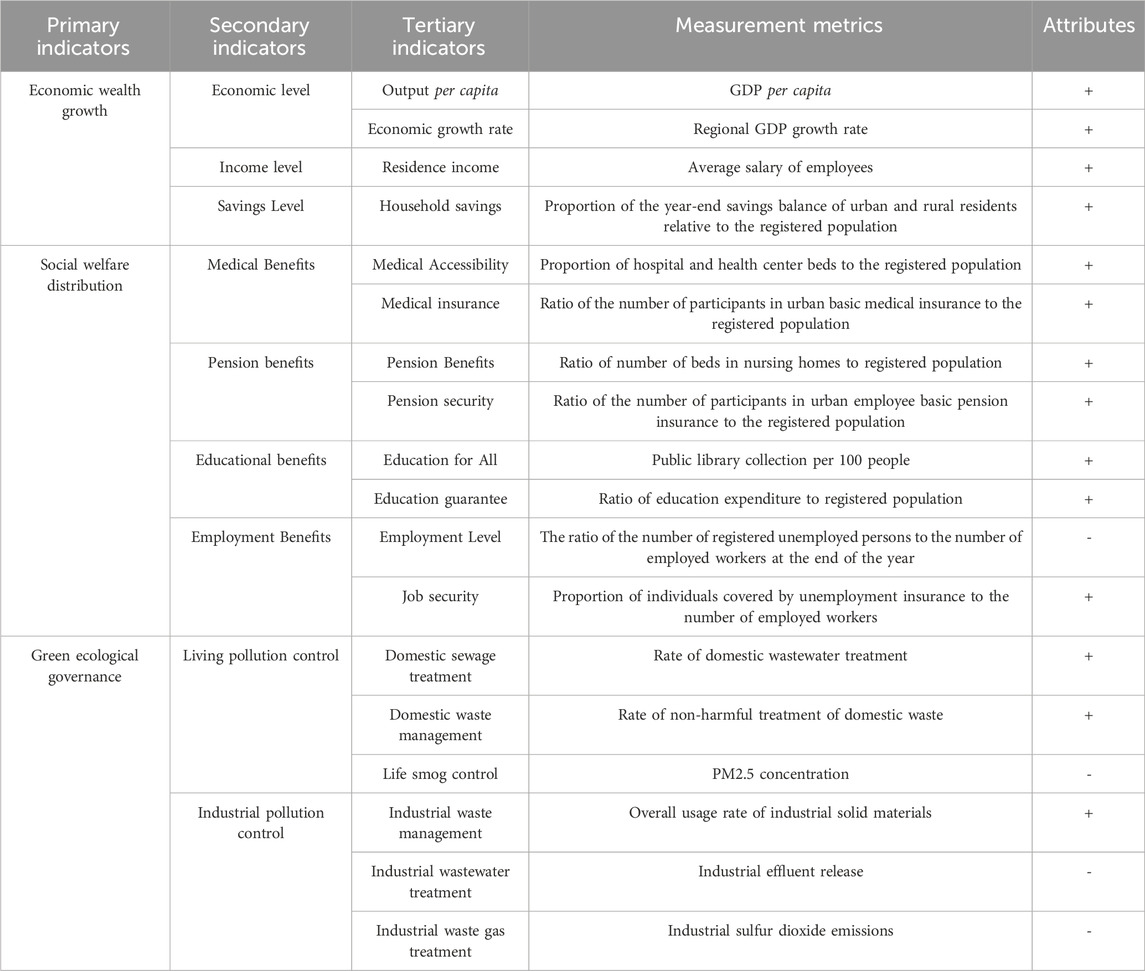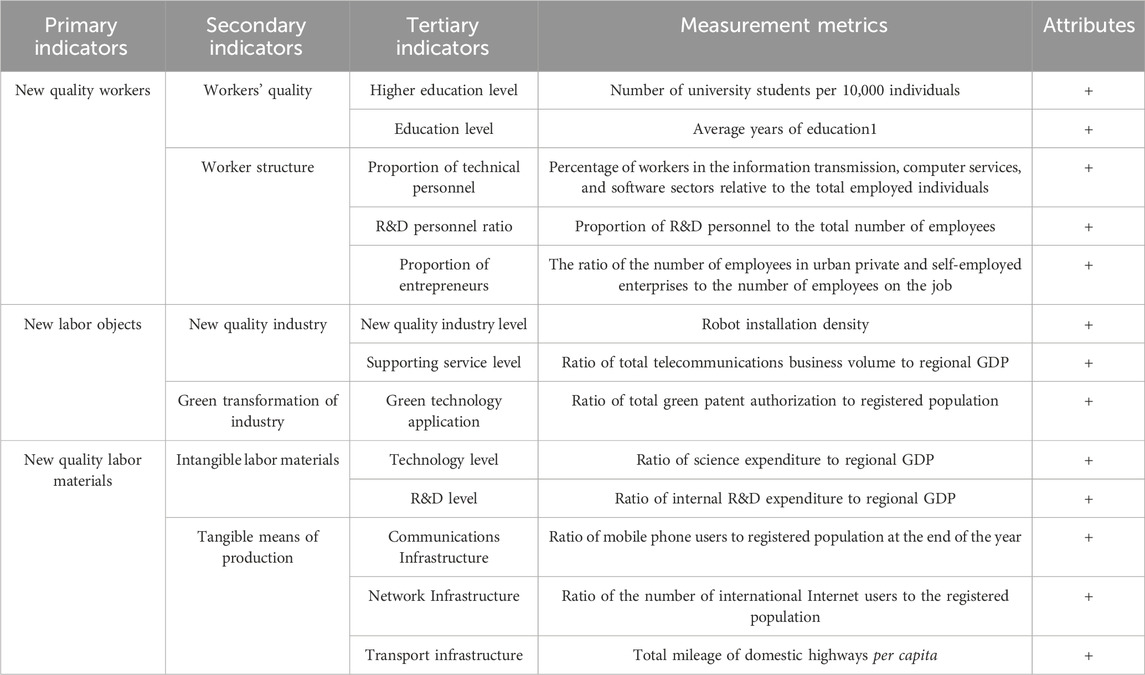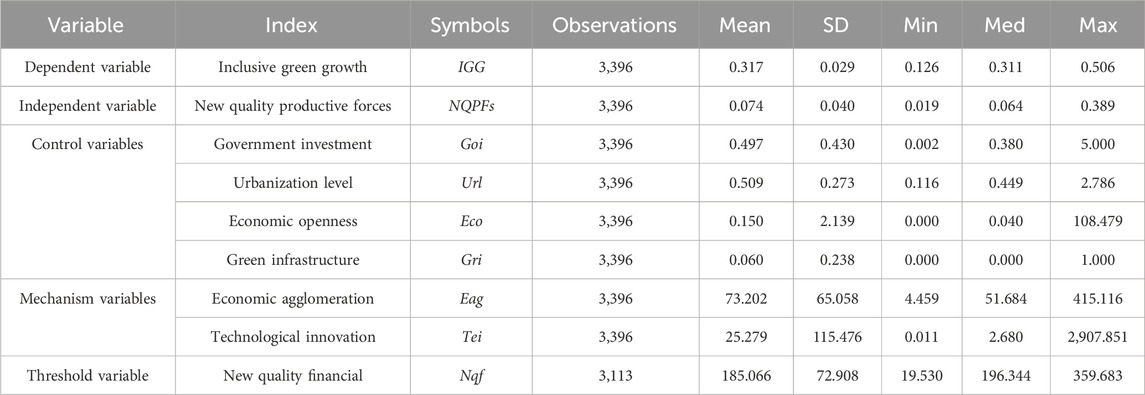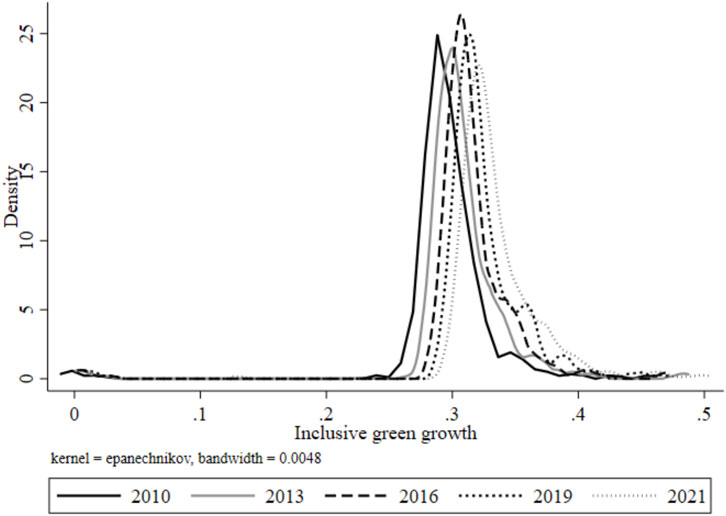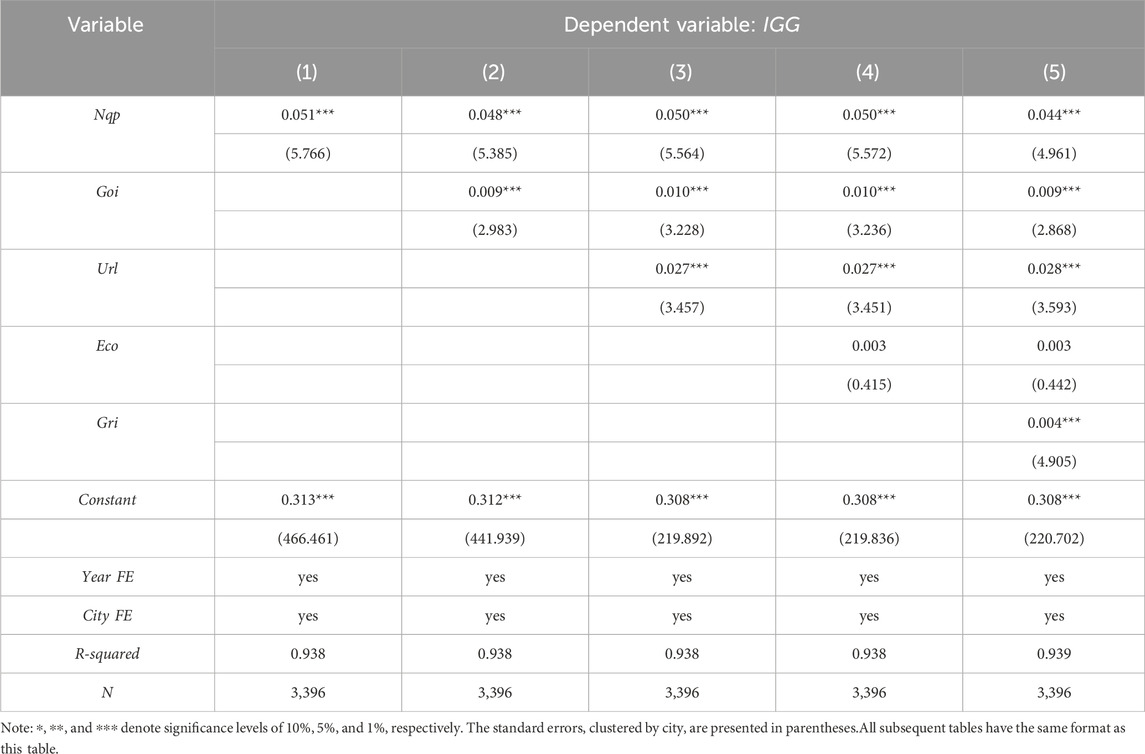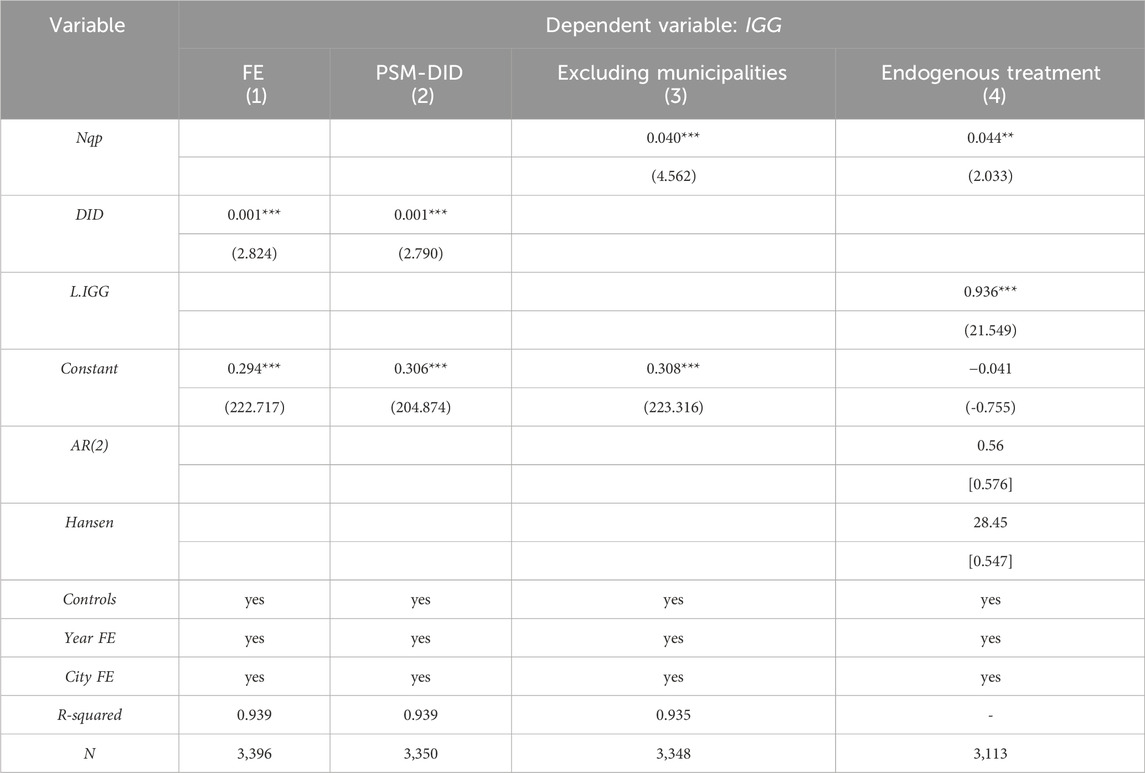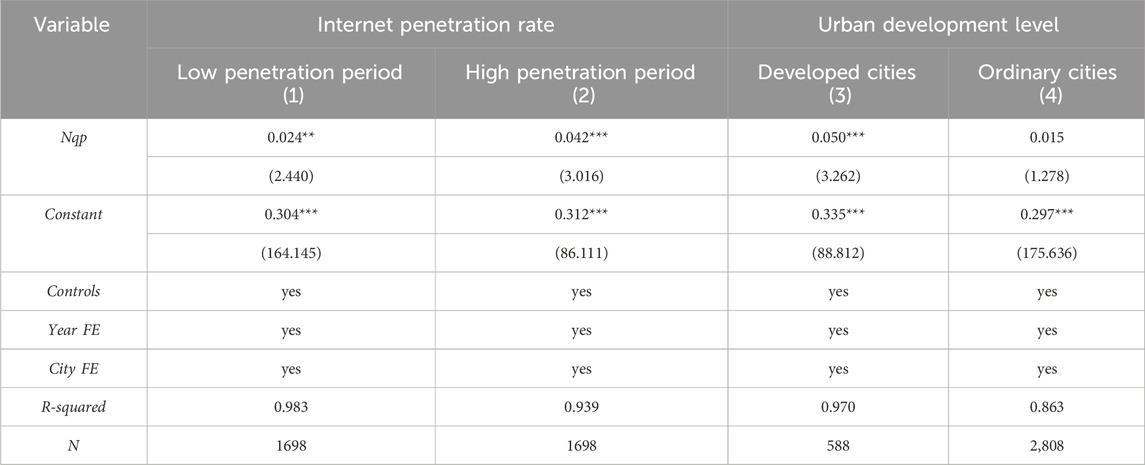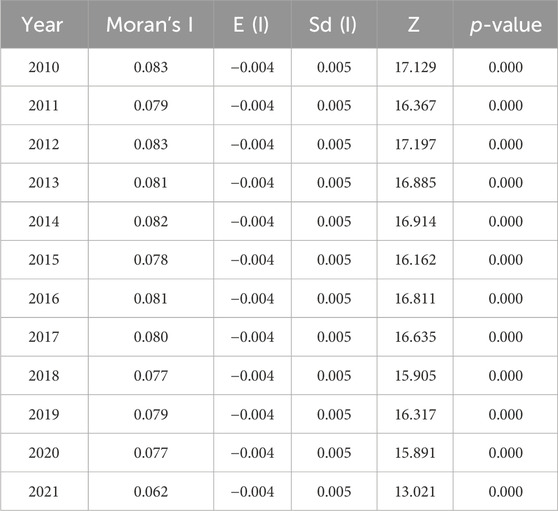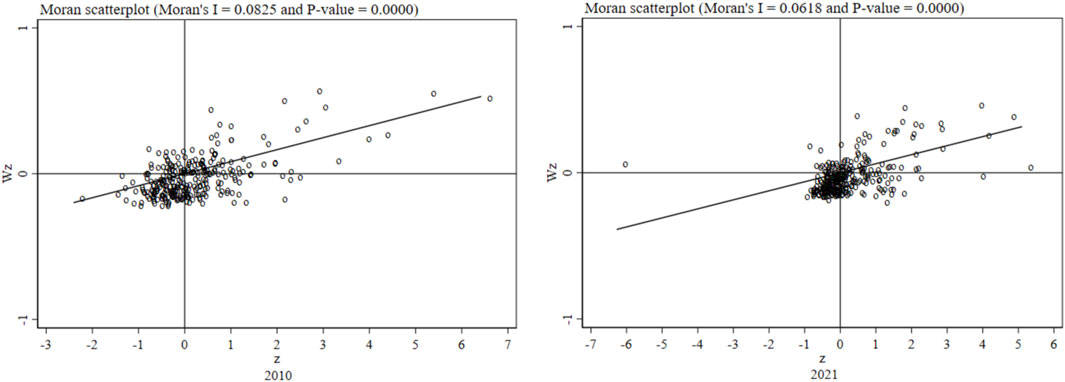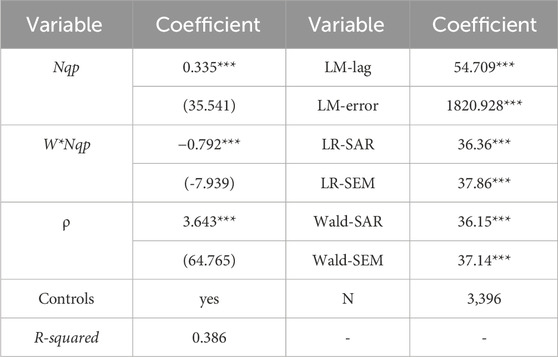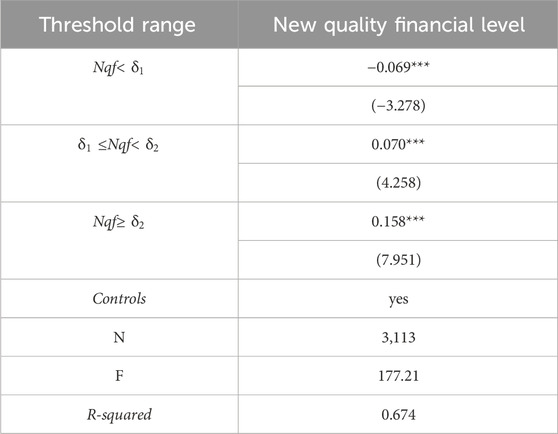- 1International Business School, Shaanxi Normal University, Xi’an, China
- 2School of Law, Beihang University, Beijing, China
Inclusive green growth (hereafter “IGG”), as a green and intensive development mode that considers both fairness and efficiency, environmental protection and development, is crucial for achieving sustainable development. New quality productive forces (hereafter “NQPFs”) have become a novel and significant factor in promoting IGG. This study aims to examine the connection between NQPFs and IGG. Based on the data from 283 Chinese cities between 2010 and 2021, the “CRITIC-entropy value” objective combination weighting method is adopted to establish comprehensive indicator system of NQPFs and IGG in this paper. The spatiotemporal characteristics, mutual relationship and influencing mechanism of NQPFs and IGG are evaluated based on kernel density function, panel fixed effect model and spatial Durbin model. The results show that both NQPFs and IGG in China have shown a steady upward trend. NQPFs can significantly promote IGG, and economic agglomeration and technological innovation are important approaches to their interaction. In the period of high Internet penetration and in developed cities, the role of NQPFs in promoting IGG is more obvious. There is also a double threshold effect of financial development in this promotion process. With financial development improving, this promotion effect is significantly enhanced. Our research advocates promoting IGG by enhancing NQPFs, thereby protecting the earth’s ecological environment and attaining long-term sustainability of human society.
1 Introduction
Global environmental pollution has become increasingly prominent with the advancement of the economy, population growth, and urbanization. Statistics show that in 2021, the worldwide economic production increased to 100.56 trillion US dollars, and the population size reached 7.837 billion. Industrialization and modernization have promoted the continuous transformation of agricultural population into urban population, but the accompanying environmental pollution, resource waste and energy supply shortages have threatened the enduring progress of human society. How to efficiently use natural resources and achieve sustainable economic growth while repairing old environmental damage has emerged as a major topic of broad interest in countries around the world. In 2012, the World Bank released a report entitled “Inclusive Green Growth: The Path to Sustainable Development,” which first proposed the concept of “inclusive green growth” (World Bank, 2012). Inclusive green growth (hereafter “IGG”) is a long-term sustainability strategy that considers fairness and efficiency, environmental conservation and development at the same time (Dhekra and Jiajun, 2023). It can achieve green and intensive development while ensuring social and economic growth and equal opportunities for residents (Viktor et al., 2023). It is highly important to protecting the earth’s ecological environment and achieve sustainable development of human society.
With the rapid advance of the new wave of technological and industrial revolution, productivity and production methods have achieved breakthrough progress and demonstrated strong driving forces and support for economic development. In 2023, Chinese President Xi Jinping initially introduced the concept of “New quality productive forces” (Qingxin and Zheng, 2024). New quality productive forces (hereafter “NQPFs”) are advanced productive forces that are aligned with the new development philosophy and defined by advanced technology, high efficiency, and superior quality, with innovation playing a leading role (Yu and Zhang, 2024). As a new type of productivity formed by the leap from traditional productivity, NQPFs have the characteristics of innovation-driven, green development and global coordination. It is committed to achieving the “three wins” of economic benefits, social benefits and ecological benefits (Yuchen and Gang, 2024; Chonghui, 2023). Obviously, NQPFs provide material power and scientific guidance for promoting IGG. So, through what channels does it promote IGG? What is the difference between it and the promotion of traditional productivity? What are the characteristics of its promotion? Considering the aforementioned issues, this paper conducts research and discussion.
The main contributions of this paper are as follows: Firstly, it expands the scope of research. Earlier works predominantly centered on the conceptual dissection of NQPFs or IGG, with a dearth of research endeavoring to perform empirical assessments of these constructs. This inquiry leverages the objective synthesis weighting technique of “CRITIC-entropy value” to quantify the NQPFs and IGG metrics across 283 Chinese municipalities, thereby amplifying the exploratory scope within this academic sphere. Secondly, the research perspective has been expanded. While the majority of studies highlight the pivotality of technological advancements or strategic formulations in IGG, scant literature delves into the ramifications of productivity shifts in IGG. This study aims to scrutinize the influence of NQPFs on IGG from a productivity standpoint. Thirdly, it enriches the research content. This research extends the current investigative framework by thoroughly examining the pathways through which NQPFs exert an influence on IGG, offering beneficial enlightenment as a foundational reference for analogous studies. However, this paper also has some limitations that need to be further improved in future research. Firstly, the factors that affect IGG are multifaceted and constantly changing, such as policy systems, laws and regulations, wars, international cooperation and competition, etc. In addition, the impact of various factors on IGG is different, and further analysis is needed to determine whether NQPFs play a dominant or auxiliary role. Secondly, there are certain challenges in how to transform research results into practical guidance, thereby enhancing the influence and practical value of research on various countries.
2 Literature review
The concept of “productivity” first came from the book “The Theory of Grain” by the founder of the French Physiocrats and classical economist François Quesnay (Quesnay, 1979). Since then, scholars such as Adam Smith, David Ricardo and Friedrich List have supplemented the category of productivity (Smith, 1979; Ricardo, 1962; List, 1961). On the basis of critically inheriting the productivity theory of the above classical economists, Marx and Engels revealed the essence of productivity from the perspective of “social productivity” (Marx, 2012). They believed that “productivity is of course always useful, concrete, and labor productivity” and that “productivity also includes science” (Marx, 2009). Grounded in the research of predecessors and the characteristics of the era of economic development under the wave of scientific and technological revolution, Chinese President Xi Jinping has made further innovations in the theory of productivity and put forward the concept of “New quality productive forces” (Zongyuan and Wu, 2024). NQPFs come from information-based, intelligent, and digital production practices (Wenlong et al., 2024; Han et al., 2024). They are NQPFs generated by empowering old production factors with new technologies (Yuan and Han, 2024).
IGG is a new development concept that has emerged in recent years, and related research mainly focuses on two aspects: one is the definition of the connotation of IGG. In 2012, the World Bank defined IGG as a sustainable development model that combines both “inclusive growth” and “green growth” characteristics. Wang et al. (2024) believe that IGG not only emphasizes social welfare equity, but also attaches importance to environmental greenness and social inclusiveness. Feng et al. (2024) believes that IGG is a sustainable development approach that pursues the coordination of economic growth, social equity, and ecological environment. It is an important way and specific form to achieve the coordinated development of the three major systems of economy, society, and nature, and to promote high-quality development. The second is about measuring the level of IGG. Wu (2019) constructed an indicator evaluation system based on the theoretical connotation of IGG, measuring China’s level of IGG from four dimensions: economic development, social opportunity equity, green production and consumption, and ecological environment protection. Qian and Ning (2024) quantitatively measured the efficiency of IGG in cities using a Super SBM model with unexpected output, non orientation, and constant returns to scale.
Although there are few articles regarding the effect of NQPFs on IGG, the influence of digitalization, informatization, and intelligent transformation on IGG has been widely studied in academia. In terms of digitalization, Xiaoxue et al. (2022) confirmed that digitalization is the core driving factor of urban IGG. Ma et al. (2024), Chunhua et al. (2023) believe that the expansion of the digital economy is a favorable channel for promoting IGG. Fan Shuangshuang et al. (2023) found that digital finance plays a crucial role in advancing urban IGG. In terms of informatization, (Shuming et al., 2022; Zhang and Junchao, 2023; Zhiguo et al., 2023) found that the promotion and popularization of network infrastructure has a substantial beneficial impact on IGG. In terms of intelligent transformation, Pascale and Romagno (2024) conducted a study using datasets from 95 countries in 2010 and 2020, and found that ICT capital endowment can positively affect the IGG index.
3 Theoretical analysis and research hypotheses
3.1 Theoretical analysis
NQPFs refer to productivity led by technological innovation, emphasizing breakthroughs in key and disruptive technologies. Specifically, new technologies such as informatization, intelligence, and digitization are constantly applied and infiltrated into workers, labor materials, and labor objects, generating new quality workers, new quality labor materials, and new quality labor objects. These three new quality production factors interact with each other to generate NQPFs (Cui et al., 2024). The theoretical framework for NQPFs is shown in Figure 1.
3.2 Research hypothesis
3.2.1 NQPFs can promote IGG
There are three dimensions in which NQPFs can significantly promote IGG:
NQPFs can promote economic wealth growth. First, according to the theory of technology-economy paradigm (Robin, 2021), since new quality workers have advanced technological innovation capabilities, they can enhance labor productivity, thereby boosting economic prosperity. Second, according to the theory of economies of scale (Zou, 2024), new quality labor materials based on digital technologies such as the Internet of Things, the Internet and big data can reduce the marginal costs of related enterprises, promote their economies of scale, and thus promote economic wealth growth. Third, with the advancement of new quality labor objects, the vitality of new market entities and private economies such as enterprises is constantly stimulated (Liu et al., 2024), which helps facilitate the growth of economic wealth in society. Therefore, NQPFs can promote economic wealth growth.
NQPFs can promote the distribution of social welfare. First, because “high-quality” new quality workers have knowledge spillover effects (Kuriakose and Iyer, 2021), they are conducive to promoting the diffusion of new technologies and new knowledge to multiple entities and promoting the fair distribution of social welfare among regions. Second, new quality labor materials such as science and technology have high permeability (Kou et al., 2024), and can be integrated with traditional industries to derive many new industries and new models, thereby breaking the original welfare distribution model and promoting the distribution of social welfare in a more balanced way. Thirdly, the advancement of new quality labor objects stimulates the growth of new market entities and private economies such as enterprises (Sun, 2024), which helps facilitate the growth of economic wealth. Therefore, NQPFs can promote the distribution of social welfare.
NQPFs can promote green ecological governance. First, new quality workers in the field of green technology can promote the innovation, development, and application of green renewable energy technology, improve energy utilization efficiency (Fang, 2024), and reduce sewage and waste gas emissions, thereby promoting green ecological governance and sustainable development. Second, new quality labor materials such as digital and intelligent production systems can optimize product production processes, rationally dispatch and use resources, and reduce the generation of pollutants (Gao et al., 2024). Third, new quality labor objects mainly include new quality industries and industrial green transformation. The cultivation of new quality labor objects will help promote the advancement of low-carbon, environmentally friendly and resource-saving industries, thereby promoting green ecological governance. Therefore, NQPFs can promote green ecological governance.
3.2.2 NQPFs can promote IGG by driving economic agglomeration
NQPFs can promote IGG by promoting economic agglomeration. First, NQPFs can promote economic agglomeration. Marshall believes that economic agglomeration comes from external economies of scale (Cismaş et al., 2010). With the expansion of the development scale of new quality industries such as strategic emerging industries and future industries, firstly, the specialization of labor in new quality industries continues to deepen, and secondly, technology sharing platforms and public service platforms reduce the operating costs of new quality industries. The two work together to form external economies of scale in new quality industries, thereby promoting economic agglomeration. Second, economic agglomeration can enhance IGG. Economic agglomeration can reconstruct and integrate production factors and realize intensive and efficient use of resources. It can not only enhance operational efficiency, but also reduce the pressure of production on the ecological environment, thereby promoting IGG.
3.2.3 NQPFs can promote IGG by driving technological innovation
NQPFs can promote IGG by fostering technological innovation. First, NQPFs can promote technological innovation. Schumpeter suggested in his book “Introduction to Economic Development” that “innovation involves incorporating a novel integration of production elements and circumstances into the manufacturing system” (Schumpete, 1912). NQPFs can imporve the innovation capacity of economic entities by virtue of the continuous penetration and combination of new technologies with the three traditional productive forces. Second, technological innovation helps boost IGG. According to the theory of innovation systems, innovation activities occur in a network where multiple factors interact and connect (Jenson et al., 2016). Therefore, innovation activities can promote IGG by promoting R&D cooperation, knowledge sharing and technology transfer, as well as the movement and optimal distribution of production factors.
Based on the above analysis, we have drawn a research framework diagram of the impact of NQPFs on IGG as shown in Figure 2.
4 Research design
4.1 Model setting
4.1.1 Benchmark regression model
This paper developed the following baseline regression model to explore the relationship between NQPFs and IGG:
In Equation 1, i denotes the city, and t signifies the year;
4.1.2 Panel mediation model
This paper refers to existing research (Liu and Zhao, 2024) and sets the following panel mediation model to evaluate the process of how NQPFs influence IGG:
In Equations 2–4,
4.1.3 Panel threshold model
This paper uses the level of new quality financial as a threshold variable to further analyze the nonlinear impact of NQPFs on IGG. The panel threshold framework is established as follows:
In Equation 5,
4.1.4 Spatial durbin model
This paper constructs a spatial Durbin model to further analyze the geographic spillover effect of NQPFs on IGG. The spatial Durbin model is set as follows:
In Equation 6, W is the spatial geographic inverse distance matrix.
4.2 Variable selection
4.2.1 Dependent variable
The explained variable of this paper is inclusive green growth (IGG). Referring to existing research (Ofori et al., 2023), we construct a comprehensive indicator system from three dimensions: economic wealth growth, social welfare distribution, and green ecological governance. Since economic wealth growth includes not only macro level economic growth, but also micro level residents’ income and savings, we use three secondary indicators, economic level, income level, and savings level to represent economic wealth growth. Due to the fact that social welfare covers multiple aspects such as healthcare, elderly care, education, and employment, we use four secondary indicators, medical benefits, pension benefits, educational benefits, and employment benefits to represent the distribution of social welfare. Due to the fact that environmental pollution includes both domestic and industrial pollution, we use two secondary indicators, living pollution control and industrial pollution control to represent green ecological governance. Among the three-level indicators, employment level, haze control, industrial wastewater treatment, and industrial waste gas treatment are negative indicators, while the other variables are positive indicators. The comprehensive indicator system for inclusive green growth is shown in Table 1.
4.2.2 Independent variable
The core explanatory variable of this paper is new quality productive forces (NQPFs). Referring to Wang (2024) research, we construct a comprehensive indicator system from three dimensions: new quality workers, new quality labor objects, and new quality labor materials. Due to the fact that new quality workers not only include the quality of workers at the micro individual level, but also the structure of workers at the macro level, we use two secondary indicators, workers’ quality and worker structure to explain new quality workers. Due to the development of new quality labor objects, it is not only necessary to cultivate advanced new quality industry clusters, but also to reduce resource costs and minimize ecological damage. Therefore, we use two secondary indicators, new quality industry and green transformation of industry to represent new quality labor objects. Due to the fact that new quality labor materials include various production materials such as traditional machinery and equipment, as well as new data elements, we use two secondary indicators, namely, observable labor materials and tangible means of production to represent new quality labor materials. The comprehensive indicator system of NQPFs is shown in Table 2.
4.2.3 Mechanism variables
1) Economic agglomeration (Eag). Since night light data has the advantages of completeness, objectivity and comparability, it can effectively reflect the economic scale, population density and factor agglomeration of cities, and is therefore widely recognized by the academic community as a proxy indicator of economic agglomeration. This paper draws on the practice of (Liu and Nie, 2023), selects DMSP-OLS night light data of sample cities, and uses the average light intensity to denote the degree of urban economic concentration. 2) Technological innovation (Tei). The urban innovation index in the “China Urban and Industrial Innovation Capacity Report” jointly released by the Industrial Development Research Center of Fudan University, the First Financial Research Institute and the China Economic Research Center of Fudan University is used to measure technological innovation.
4.2.4 Control variables
1) Government investment (Goi). Government investment can not only stimulate domestic demand to promote economic growth, but also promote social equity and green industry development through the secondary distribution of wealth. We use the ratio of total fixed assets investment to registered residence population to express government investment. 2) Urbanization level (Url). The improvement of urbanization level can promote social equity by narrowing the urban-rural gap, and also stimulate economic growth by increasing the proportion of secondary and tertiary industries. We use the ratio of urban registered residence population to total registered residence population to characterize the level of urbanization. 3) Economic openness (Eco). Economic openness can not only make up for the shortage of funds for domestic economic development, but also introduce advanced technologies from other countries, thereby driving economic growth and industrial green transformation. We represent the degree of economic openness by the ratio of the total industrial output value of foreign-invested enterprises to the total industrial output value of enterprises above designated size. 4) Green infrastructure (Gri). The construction of green infrastructure is a fundamental condition for promoting the green transformation of the economy. Based on China’s “sponge city” pilot policy, we set the pilot cities as 1 and non pilot cities as 0 to represent the variable of green infrastructure.
4.2.5 Threshold variable
The threshold variable in this paper is the level of new quality financial (Nqf). Finance provides necessary financial support for the transformation of traditional industries into new industries such as high-quality and clean industries, making it a necessary threshold for NQPFs to influence IGG. We use the digital inclusive financial index to characterize the level of new quality financial. Given the availability of data, the sample interval of threshold effect test is 2011–2021.
4.3 Data source
This paper utilizes panel data from 283 cities in China from 2010 to 2021 as the study sample. The data primarily originates from the “China City Statistical Yearbook,” “China City and Industry Innovation Capacity Report,” local statistical bureaus, ESP database, National Intellectual Property Administration and the National Oceanic and Atmospheric Administration of the United States. The summary statistics of the variables are shown in Table 3. Among these, NQPFs and IGG are grounded in the aforementioned comprehensive indicator system and are measured by the “CRITIC-entropy value” objective1 combination weighting method. Before measurement, all original data in this paper are dimensionless2.
5 Empirical analysis
5.1 Development level and trend
The situation of China’s NQPFs from 2010 to 2021 is shown in Figure 3. Overall, China’s NQPFs basically showed an increasing trend from 2010 to 2021, rising from 0.053 in 2010 to 0.093 in 2021, an increase of 75% in 12 years. Before 2016, NQPFs were always lower than the average of 0.074. Since 2016, NQPFs have exceeded the average. Except for a slight decline in 2019, the remaining years have maintained a steady upward trajectory, peaking at 0.093 in 2021. This shows that China’s NQPFs continued to improve during the sample period, and maintained a relatively fast progress rate overall.
The distribution of China’s IGG kernel density from 2010 to 2021 is shown in Figure 4. It is evident that the peak of China’s IGG kernel density curve is concentrated around 0.29–0.33, and the peak of the kernel density curve keeps moving to the righ throughout the observation period, indicating that China’s IGG level continues to improve. The height of the main peak has been decreasing since 2016, indicating that the degree of difference in IGG among cities has expanded. From the viewpoint of the number of peaks, the gradual transition from a single peak to a multi-peak pattern indicates that China’s IGG has gradually evolved from a unipolar to a multi-polar development trend. In addition, the overall kernel density curve has a left-right tailing feature, signifying that the variations in IGG levels among cities are more obvious.
5.2 Baseline regression
The initial regression results are displayed in Table 4. As observed in column (1) of Table 4, when only accounting for time and individual fixed effects, the regression coefficient of NQPFs is 0.051 and statistically significant at the 1% level. Hypothesis 1 has been preliminarily verified. From columns (2) to (5), it can be seen that under the condition of gradually increasing the control variables, the regression coefficient of NQPFs is always strongly positive at the 1% threshold, indicating that NQPFs can effectively promote IGG. In addition, the estimated coefficients of government investment, urbanization level and green infrastructure in column (5) are all significantly positive at the 1% significance level, and the estimated coefficient of economic openness is not significant, suggesting that government intervention, urbanization level, economic Openness and green infrastructure can also effectively promote IGG, while economic openness has an insignificant effect on IGG.
5.3 Robustness test
5.3.1 Exogenous shock test method
As an important forerunner and pillar of new quality industries, telecommunications broadband networks can reflect the development status of NQPFs to a certain extent. Therefore, we use the “Broadband China” pilot to replace the development level of NQPFs to conduct a quasi-natural experiment, and use the double difference method (DID) to test whether the “Broadband China” pilot can promote IGG. Column (1) in Table 5 is the double difference estimation result obtained by double fixed effect regression, and column (2) is the estimation result obtained by the propensity score matching double difference method (PSM-DID). The specific PSM method is caliper matching. The estimation results of columns (1) and (2) show that the estimated coefficients of DID are significantly positive at the 1% level, indicating that the “Broadband China” pilot plays a crucial role in advancing IGG, and the regression results are consistent.
5.3.2 Excluding municipalities
Considering that the level of NQPFs in municipalities is quite different from that in other cities, this paper excludes four municipalities, namely, Beijing, Shanghai, Tianjin and Chongqing, and re-regresses the remaining 283 sample cities. The findings are presented in column (3) of Table 5. It is evident that after omitting the samples of municipalities, the conclusion that NQPFs can promote IGG remains robust.
5.3.3 Endogeneity treatment
In order to prevent the omitted variables from causing bias in the estimation results, we introduce the high-order lag term of the dependent variable and use the system GMM method to perform dynamic panel regression estimation. The estimated results are displayed in column (4) of Table 5. The findings indicate that the instrumental variables pass the Hansen test, suggesting that the choice of instrumental variables is appropriate and effective. The estimated coefficient of NQPFs is positive and significant, which further verifies that NQPFs can promote IGG. The benchmark regression results are still robust and effective.
5.4 Mechanism analysis
Columns (1) and (2) of Table 6 are the regression results of economic agglomeration as mechanism variables. The results in column (1) demonstrate that the role of NQPFs in promoting economic agglomeration is positive and statistically significant at the 1% level, and the regression results of column (2) show that both NQPFs and economic agglomeration significantly promote IGG at the 1% level. This shows that economic agglomeration is crucial to promoting IGG, and NQPFs can indirectly promote IGG by promoting economic agglomeration.
Columns (3) and (4) in Table 6 are the regression results of technological innovation as mechanism variables. The findings in column (3) reveal that the role of NQPFs in promoting technological innovation is favorable and significant at the 5% level, and the regression results of column (4) show that NQPFs and technological innovation significantly promote IGG at the 1% and 5% levels respectively. This shows that technological innovation is of great significance to promoting IGG, and NQPFs can indirectly promote IGG by enhancing the level of technological innovation.
5.5 Heterogeneity analysis
5.5.1 Heterogeneity of internet penetration rate
The Statistical Bulletin on National Economic and Social Development 2016, published by the National Bureau of Statistics, reveals that China’s internet coverage rate achieved 53.2% in 2016, which is the first time that the figure has exceeded 50%, indicating that China has achieved remarkable results in Internet penetration. Therefore, we divide the sample period into two time periods: 2010–2015 and 2016–2021. The former represents the period of low Internet penetration rate and the latter represents the period of high Internet penetration rate, and regress them separately. From the regression findings in columns (1) and (2) of Table 7, it is apparent that in the period of low Internet penetration rate, the role of NQPFs in promoting IGG is relatively weak, while in the period of high Internet penetration rate, NQPFs can significantly promote IGG. The reason may be that the Internet can not only offer technical assistance for the advancement of NQPFs through the dissemination of data elements, but also provide basic conditions for promoting revamping and modernizing traditional industries to new quality industries. Therefore, there is heterogeneity in Internet penetration rate during NQPFs affecting IGG.
5.5.2 Heterogeneity of urban development level
Since cities differ in their comprehensive development level, economic strength, research and development capabilities, and attractiveness to talent, the effects of NQPFs on IGG in different cities may also vary. In this section, we divide cities into different categories to examine the heterogeneity of urban development levels in terms of the impact of NQPFs on IGG. The classification criteria are to classify first-tier, new first-tier, and second-tier cities as developed cities, and third-tier and below cities as ordinary cities, and then perform separate regressions. Observing the regression results from columns (3) and (4) in Table 7, NQPFs have a significant promoting effect on IGG in developed cities, but for ordinary cities, the effect of NQPFs on IGG is not obvious. The reason may be that talent is the core competitiveness of developing NQPFs. High-quality new quality workers are relatively concentrated in developed cities. These workers can better utilize new quality labor materials to process new quality labor objects. Therefore, the development of NQPFs in developed cities has advantages over ordinary cities. Therefore, there is heterogeneity in urban development levels in the process of NQPFs affecting IGG.
5.6 Spatial spillover effect
5.6.1 Overall spatial correlation test
Before parameter estimation, this paper uses the spatial geographic inverse distance matrix to calculate the overall spatial correlation, and explores the spatial autocorrelation of IGG through the overall Moran’s I index to determine whether it has a spatial spillover effect. The overall Moran’s I calculated value and its significance level are shown in Table 8. As presented in Table 8, the overall Moran’s I of China’s IGG from 2010 to 2021 is significantly positive at the 1% level, which shows that China’s IGG has an obvious positive spatial correlation. During the sample period, the overall Moran’s I calculated value showed a decreasing trend, indicating that the geographic correlation of China’s IGG has the characteristics of diminishing marginal effects.
5.6.2 Local spatial correlation test
To further examine the regional clustering and spatiotemporal transition law of China’s IGG, this paper depicts the local Moran’s I scatter plot of China’s IGG in 2010 and 2021 (Figure 5). By observing the local Moran’s I scatter plot, it can be seen that most cities in 2010 and 2021 are located in the third quadrant, that is, they show obvious low-low (L-L) clustered distribution characteristics, indicating that the local spatial correlation of China’s IGG is significant.
5.6.3 Spatial spillover effect test
Building on the spatial correlation test previously discussed, it is reasonable to analyze the spatial spillover effect of NQPFs on IGG. Further, we choose the spatial econometric model using the LM test, LR test, and WALD test. The estimation results in Table 9 indicate that all the aforementioned tests are significant at the 1% level, indicating that compared with SAR and SEM models, the SDM model is more appropriate. Consequently, this paper employs the spatial geographic inverse distance matrix to build the SDM model with fixed time effects to examine the spatial spillover effect. As observed in Table 9, the interaction term between NQPFs and the spatial geographic inverse distance matrix is significantly negative, while the spatial lag term ρ is significantly positive, indicating that the sample has a negative exogenous interaction effect driven by NQPFs and a positive endogenous interaction effect of IGG in space, that is, NQPFs will inhibit the IGG of surrounding cities. Simultaneously, IGG exhibits a positive spatial diffusion effect on itself.
In order to avoid the influence of spatial lag on the estimation results, we use partial differential equations to decompose the SDM model. Table 10 shows the decomposition results of the spatial spillover effect of the SDM model. As illustrated in Table 10, the estimated values for the direct impact, indirect impact (spatial spillover effect), and overall impact of NQPFs are 0.337, −0.166, and 0.171, correspondingly, all of which are statistically significant at the 1% threshold, indicating that NQPFs have a significant promoting effect on the IGG of the city, while it has an inhibitory effect on the IGG of surrounding cities. Overall, NQPFs are conducive to promoting IGG. In terms of proportion, the direct effect and indirect effect account for 66.998% and 33.002% of the total effect respectively. The direct effect is significantly greater than the indirect effect, indicating that the promoting effect of NQPFs on the IGG of the city far exceeds the inhibitory effect on the IGG of surrounding cities.
The reason is that the impact of NQPFs on IGG may have both “centripetal force” and “centrifugal force.” On the one hand, NQPFs can promote the IGG of the city by promoting economic agglomeration and improving the level of technological innovation. On the other hand, the development of NQPFs in the city may have a “siphon effect” on surrounding cities, absorbing new quality workers and other resources from surrounding cities, thereby inhibiting the IGG of surrounding cities.
5.7 Threshold effect test
In the process of promoting IGG, NQPFs may have a nonlinear threshold of new quality financial level. In this section, we use the digital inclusive financial index as the threshold variable to test the threshold effect. First, the existence of the threshold of NQPFs to promote IGG is tested by 300 self-help repeated sampling methods. The test results are presented in Table 11. It is evident that the new quality financial level passed the double threshold test, among which the single threshold value is 0.466, the F value is 1300.34, the double threshold value is 0.663, and the F value is 619.25, all of which are significant at the 1% level, suggesting that there exists a double threshold effect of new quality financial level in the process of promoting IGG by NQPFs.
Subsequently, we conducted a threshold effect regression on the sample, and the regression findings are displayed in Table 12. As illustrated in Table 12, when the level of new quality finance does not cross the first threshold value (Nqf <
6 Discussions
The production methods represented by NQPFs are reshaping social production relations and providing sustained impetus for the modernization of the economy and society. Therefore, clarifying the underlying mechanism and implementation path of NQPFs affecting IGG has substantial theoretical and practical significance. Previous studies have mainly explored the impact of digitalization, informatization, and intelligent transformation on IGG (Xiaoxue et al., 2022; Zhu Jinhe and Pang Wanyu, 2023; Chunhua et al., 2023); However, there are not many empirical studies examining the causal relationship between the two from a macro perspective (Shuming et al., 2022). Based on theoretical analysis, this study utilized data from 283 cities in China from 2010 to 2021 and established a comprehensive index system for NQPFs and IGG using the objective combination weighting method of “CRITIC entropy.” The spatiotemporal variation characteristics of both were evaluated based on kernel density function, and the impact of NQPFs on IGG and its underlying mechanisms was examined using a panel fixed effects model and spatial Durbin model.
This study provides valuable insights and promotes academic development. Specifically, we examined the applicability of technology economy paradigm theory, scale economy theory, innovation system theory, and other theories to explain the relationship between NQPFs and IGG in the Chinese context, providing theoretical references for related research. Secondly, we found that economic agglomeration and technological innovation are the mediating transmission mechanisms of NQPFs’ impact on IGG. In other words, improving economic agglomeration and technological innovation level is a crucial way to promote IGG. Furthermore, we find that NQPFs have a stronger positive impact on IGG during the period of high Internet penetration. Developed cities are the biggest winners of NQPFs development, significantly promoting the level of IGG in their own cities. In addition, contrary to our own city, we found that NQPFs have an inhibitory effect on the growth of IGG in surrounding cities. Finally, the threshold effect of NQPFs on promoting IGG was examined based on the level of new quality finance.
7 Conclusion and policy implications
This paper explores the effects and underlying mechanisms of NQPFs on IGG, and draws the following conclusions: 1) China’s NQPFs have shown an overall upward trend, rising from 0.082 in 2010 to 0.110 in 2021, an increase of 33% in 12 years; from a dimensional perspective, the level of new quality workers is higher than that of new quality labor objects and new quality means of production. 2) China’s IGG level continued to improve during the sample period, and gradually evolved from a unipolar development trend to a bipolar development trend. The differences in IGG among cities are obvious, and the degree of difference has increased. 3) NQPFs are capable of promoting IGG, and this conclusion holds up after robustness tests. In addition, government intervention, urbanization level, economic openness and green infrastructure are also important factors in promoting IGG. 4) NQPFs can contribute to IGG indirectly by promoting economic agglomerations and enhancing technological development. 5) During the course of NQPFs affecting IGG, there is heterogeneity in Internet penetration rate and urban development level. In the period of high Internet penetration rate and developed cities, the role of NQPFs in promoting IGG is more obvious. 6) In the city, NQPFs significantly enhance IGG, whereas they suppress IGG in nearby cities. 7) In the process of promoting IGG, NQPFs have a double threshold effect of new quality financial level. As the quality of new quality financial level, the role of NQPFs in promoting IGG has been significantly enhanced.
The research results of this paper provide several insights for policymakers: 1) Take the development of NQPFs as an important opportunity to promote IGG, and coordinate the construction of the “hard environment” and “soft environment” for the development of NQPFs. On the one hand, we should increase the investment in the construction of objective productivity, that is, increase the investment in the construction of new high-quality labor resources and new high-quality labor assets. Additionally, we should focus on the development of subjective productivity, that is, orderly promote the education and training of new quality workers, and enhance the ability of new quality workers to use new quality labor materials to produce new quality labor objects. 2) We should fully recognize the pivotal role of production factors in the relationship between developing NQPFs and promoting IGG. While encouraging the flow and agglomeration of production factors, we should enhance the oversight and management of the production factor market, timely adjust the flow direction and flow speed of production factors, and prevent the “siphon effect” brought about by the development of NQPFs from inhibiting the IGG of surrounding cities. Finally, due to the novelty of the NQPFs, it is incumbent upon China’s policymakers and regulators to design and complete the supplementary regulatory framework.
Data availability statement
The original contributions presented in the study are included in the article/supplementary material, further inquiries can be directed to the corresponding author.
Author contributions
QW: Conceptualization, Data curation, Investigation, Methodology, Software, Supervision, Writing–original draft. XC: Formal Analysis, Funding acquisition, Project administration, Resources, Validation, Visualization, Writing–review and editing.
Funding
The author(s) declare that financial support was received for the research, authorship, and/or publication of this article. This research supported by (the Fundamental Research Funds for the Central Universities) grant number (KG16319401).
Conflict of interest
The authors declare that the research was conducted in the absence of any commercial or financial relationships that could be construed as a potential conflict of interest.
Publisher’s note
All claims expressed in this article are solely those of the authors and do not necessarily represent those of their affiliated organizations, or those of the publisher, the editors and the reviewers. Any product that may be evaluated in this article, or claim that may be made by its manufacturer, is not guaranteed or endorsed by the publisher.
Footnotes
1Average years of education = (number of people not attending school*0 + number of students in primary schools*6 + number of students in junior high schools*9 + number of students in high schools*12 + number of students in regular colleges and universities*16)/registered population.
2The dimensionless formula of the positive indicator is
References
Chonghui, W. (2023). The basic meaning, historical evolution and practical path of new quality productivity. Theory Reform (06), 25–38. doi:10.13553/j.cnki.llygg.2023.06.003
Chunhua, X., Shuangshuang, F., William, M., and Shahbaz, M. (2023). Towards inclusive green growth: does digital economy matter? Environ. Sci. Pollut. Res. Int. 30 (27), 70348–70370. doi:10.1007/s11356-023-27357-8
Cismaş, L., Miculescu, A., and Oţil, M. (2010). Current trends of the regional development policy in the European Union. the development of competitive economic agglomerations of cluster type. Ann. Univ. Petrosani Econ. X (2), 99.
Cui, Z., Ren, Z., and Wang, Q. (2024). The question of the formation of new quality productivity: rethinking in the context of marx's scientific and technological thought. Econ. Issues (10), 11–21. doi:10.16011/j.cnki.jjwt.2024.10.004
Dhekra, A. B., and Jiajun, Q. (2023). From economic growth to inclusive green growth: how do carbon emissions, eco-innovation and international collaboration develop economic growth and tackle climate change? J. Clean. Prod., 425. doi:10.1016/j.jclepro.2023.138986
Fang, Z. (2024). New quality productivity and green economy: internal fit and practical combination. J. China Univ. Min. Technol. Soc. Sci. Ed., 1–11. doi:10.20089/j.cnki.issn.1009-105x.2024.03.002
Feng, Y., Sun, M., Pan, Y., and Zhang, C. (2024). Fostering inclusive green growth in China: identifying the impact of the regional integration strategy of Yangtze River Economic Belt. J. Environ. Manag. 358, 358120952–120952. doi:10.1016/j.jenvman.2024.120952
Gao, M., Wei, H., Li, L., and Zhuo, F. (2024). How data factor flow affects corporate pollution reduction: the environmental effects of digital empowerment. J. Clean. Prod. 478, 478143946–143946. doi:10.1016/j.jclepro.2024.143946
Han, W., Zhang, R., and Feng, Z. (2024). Calculation of the level of new quality productivity and new driving force of China's economic growth. Quantitative Econ. Tech. Econ. Res., 1–22. doi:10.13653/j.cnki.jqte.20240418.001
Jenson, I., Leith, P., Doyle, R., West, J., and Miles, M. P. (2016). The root cause of innovation system problems: formative measures and causal configurations. J. Bus. Res. 69 (11), 5292–5298. doi:10.1016/j.jbusres.2016.04.127
Kou, M., Yang, Y., and Chen, K. (2024). Financial technology research: past and future trajectories. Int. Rev. Econ. Finance 93 (PA), 162–181. doi:10.1016/j.iref.2024.03.032
Kuriakose, F., and Iyer, K. D. (2021). Digital workers, urban vectors, and new economies: examining labor response, resistance, and reorganization under platform capitalism. South Atl. Q. 120 (4), 749–762. doi:10.1215/00382876-9443308
Liu, D., Yang, R., Zhu, X., and Yi, T. (2024). New quality productivity and technological innovation. China Sci. Technol. Forum (03), 1–5. doi:10.13580/j.cnki.fstc.2024.03.001
Liu, J., and Zhao, Q. (2024). Mechanism testing of the empowerment of green transformation and upgrading of industry by the digital economy in China. Front. Environ. Sci. 11. doi:10.3389/fenvs.2023.1292795
Liu, Z., and Nie, P. (2023). Coordinated development of economic agglomeration, industrial structure upgrading and green economic efficiency: a comparative analysis based on the Beijing-Tianjin-Hebei and Guangdong-Hong Kong-Macao Greater Bay Area. Beijing Soc. Sci. (12), 29–43. doi:10.13262/j.bjsshkxy.bjshkx.231203
Ma, R., Liu, H., Li, Z., Ma, Y., and Fu, S. (2024). Promoting sustainable development: revisiting digital economy agglomeration and inclusive green growth through two-tier stochastic frontier model. J. Environ. Manag. 355, 355120491–120491. doi:10.1016/j.jenvman.2024.120491
Ofori, I. K., Gbolonyo, E. Y., and Ojong, N. (2023). Foreign direct investment and inclusive green growth in Africa: energy efficiency contingencies and thresholds. Energy Econ., 126. doi:10.1016/J.ENECO.2022.106414
Pascale, D. G., and Romagno, A. (2024). Globalization and ICT capital endowment: how do they impact on an inclusive Green Growth Index? Struct. Change Econ. Dyn., 69463–69474. doi:10.1016/J.STRUECO.2024.03.003
Qian, M., and Ning, L. (2024). Zhang Hongbing Network infrastructure construction, knowledge flow, and inclusive green growth in cities: a comprehensive analysis framework based on regulatory intermediaries and chain intermediaries. Stat. Res. 41 (08), 98–111. doi:10.19343/j.cnki.11-1302/c.2024.08.007
Qingxin, C., and Zheng, Z. (2024). An analysis of the connotation of comprehensively deepening reform and empowering new quality productive forces in the new era. Southeast Academic, 15–26. doi:10.13658/j.cnki.sar.20240829.006
Robin, M. (2021). Adjusting to the digital: societal outcomes and consequences. Res. Policy 50 (9), 104296. doi:10.1016/j.respol.2021.104296
Shuangshuang, F., Hongyun, H., William, M., and Zhao, X. (2023). A step toward inclusive green growth: can digital finance be the main engine? Environ. Sci. Pollut. Res. Int. 30 (42), 96075–96097. doi:10.1007/s11356-023-29155-8
Shuming, R., Lianqing, L., Yueqi, H., Hao, Y., and Wu, H. (2022). The emerging driving force of inclusive green growth: does digital economy agglomeration work? Bus. Strategy Environ. 31 (4), 1656–1678. doi:10.1002/bse.2975
Sun, Z. (2024). The impact and mechanism of digital new quality productivity on high-quality integration of urban and rural areas. China Circ. Econ. 38 (05), 28–40. doi:10.14089/j.cnki.cn11-3664/f.2024.05.003
Viktor, S., Philipp, K., and A, C. H. (2023). Multidimensional economic complexity and inclusive green growth. Commun. Earth Environ. 4 (1), 130. doi:10.1038/s43247-023-00770-0
Wang, H., Li, W., Xiao, H., and Wang, D. (2024). Horizontal ecological compensation and urban inclusive green growth: evidence from China. Front. Public Health 12, 121415309–1415309. doi:10.3389/fpubh.2024.1415309
Wang, J. (2024). New quality productivity: a theoretical framework and indicator system. J. Northwest Univ. Philosophy Soc. Sci. Ed., 1–10. doi:10.16152/j.cnki.xdxbsk.2024-01-004
World Bank (2012). Inclusive green growth: the pathway to sustainable development. Chicago, IL: World Bank Publication.
Wu, W. (2019). Zhou Xiaoliang construction and application of performance evaluation system for inclusive green growth in China. Chin. Manag. Sci. 27 (09), 183–194. doi:10.16381/j.cnki.issn1003-207x.2019.09.018
Xiaoxue, L., Shuangshuang, F., Fuzhen, C., Shengnan, P., and Hongyun, H. (2022). Study on the drivers of inclusive green growth in China based on the digital economy represented by the internet of Things (IoT). Comput. Intell. Neurosci. 2022, 8340371. doi:10.1155/2022/8340371
Yu, L., and Zhang, Q. (2024). Measurement of new qualitative productivity kinetic energy from the perspective of digital and green collaboration--comparative study based on European countries. J. Clean. Prod. 476, 476143787–143787. doi:10.1016/j.jclepro.2024.143787
Yuan, H., and Han, J. (2024). Research on artificial intelligence promoting the development of new quality productivity. Nanjing, China: Modern Economic Discussion, 10–19. doi:10.13891/j.cnki.mer.2024.10.002
Yuchen, L., and Gang, C. (2024). An analysis of digital finance in promoting the development of new quality productivity. Proc. Bus. Econ. Stud. 7 (5), 227–233. doi:10.26689/pbes.v7i5.8620
Zhang, T., and Junchao, L. (2023). Network infrastructure, inclusive green growth and regional disparity - causal inference based on dual machine learning. Res. Quantitative Tech. Econ. 40 (04), 113–135. doi:10.13653/j.cnki.jqte.20230310.005
Zhiguo, L., Zhaozhe, L., and Weijia, K. (2023). Digital infrastructure construction enables inclusive green growth: internal mechanism and empirical evidence. Zhejiang Soc. Sci. (08), 15–24+156. doi:10.14167/j.zjss.2023.08.013
Zongyuan, L., and Wu, S. (2024). Developing new quality productive forces requires handling five major relationships - from the perspective of revolutionary innovation Shanghai. Econ. Res. (10), 5–16. doi:10.19626/j.cnki.cn31-1163/f.2024.10.005
Keywords: inclusive green growth, new quality productive forces, sustainable development, economic agglomeration, technological innovation
Citation: Wang Q and Chen X (2024) Can new quality productive forces promote inclusive green growth: evidence from China. Front. Environ. Sci. 12:1499756. doi: 10.3389/fenvs.2024.1499756
Received: 21 September 2024; Accepted: 29 November 2024;
Published: 17 December 2024.
Edited by:
Mirela Panait, Petroleum and Gas University of Ploieşti, RomaniaReviewed by:
Laeeq Razzak Janjua, WSB Universities, PolandOrhan Şanli, Adnan Menderes University, Türkiye
Copyright © 2024 Wang and Chen. This is an open-access article distributed under the terms of the Creative Commons Attribution License (CC BY). The use, distribution or reproduction in other forums is permitted, provided the original author(s) and the copyright owner(s) are credited and that the original publication in this journal is cited, in accordance with accepted academic practice. No use, distribution or reproduction is permitted which does not comply with these terms.
*Correspondence: Xiayang Chen, eGlheWFuZ2NoZW4xOTk0QDE2My5jb20=
 Qi Wang
Qi Wang Xiayang Chen
Xiayang Chen